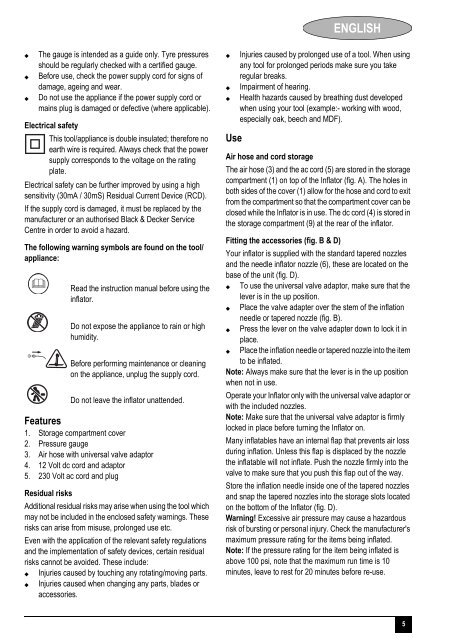BlackandDecker Gonfleur- Asi300 - Type 3 - Instruction Manual (Européen)
BlackandDecker Gonfleur- Asi300 - Type 3 - Instruction Manual (Européen)
BlackandDecker Gonfleur- Asi300 - Type 3 - Instruction Manual (Européen)
Create successful ePaper yourself
Turn your PDF publications into a flip-book with our unique Google optimized e-Paper software.
ENGLISH<br />
<br />
<br />
<br />
The gauge is int<strong>en</strong>ded as a guide only. Tyre pressures<br />
should be regularly checked with a certified gauge.<br />
Before use, check the power supply cord for signs of<br />
damage, ageing and wear.<br />
Do not use the appliance if the power supply cord or<br />
mains plug is damaged or defective (where applicable).<br />
Electrical safety<br />
This tool/appliance is double insulated; therefore no<br />
earth wire is required. Always check that the power<br />
supply corresponds to the voltage on the rating<br />
plate.<br />
Electrical safety can be further improved by using a high<br />
s<strong>en</strong>sitivity (30mA / 30mS) Residual Curr<strong>en</strong>t Device (RCD).<br />
If the supply cord is damaged, it must be replaced by the<br />
manufacturer or an authorised Black & Decker Service<br />
C<strong>en</strong>tre in order to avoid a hazard.<br />
The following warning symbols are found on the tool/<br />
appliance:<br />
Read the instruction manual before using the<br />
inflator.<br />
Do not expose the appliance to rain or high<br />
humidity.<br />
Before performing maint<strong>en</strong>ance or cleaning<br />
on the appliance, unplug the supply cord.<br />
Do not leave the inflator unatt<strong>en</strong>ded.<br />
Features<br />
1. Storage compartm<strong>en</strong>t cover<br />
2. Pressure gauge<br />
3. Air hose with universal valve adaptor<br />
4. 12 Volt dc cord and adaptor<br />
5. 230 Volt ac cord and plug<br />
Residual risks<br />
Additional residual risks may arise wh<strong>en</strong> using the tool which<br />
may not be included in the <strong>en</strong>closed safety warnings. These<br />
risks can arise from misuse, prolonged use etc.<br />
Ev<strong>en</strong> with the application of the relevant safety regulations<br />
and the implem<strong>en</strong>tation of safety devices, certain residual<br />
risks cannot be avoided. These include:<br />
Injuries caused by touching any rotating/moving parts.<br />
Injuries caused wh<strong>en</strong> changing any parts, blades or<br />
accessories.<br />
<br />
<br />
<br />
Use<br />
Injuries caused by prolonged use of a tool. Wh<strong>en</strong> using<br />
any tool for prolonged periods make sure you take<br />
regular breaks.<br />
Impairm<strong>en</strong>t of hearing.<br />
Health hazards caused by breathing dust developed<br />
wh<strong>en</strong> using your tool (example:- working with wood,<br />
especially oak, beech and MDF).<br />
Air hose and cord storage<br />
The air hose (3) and the ac cord (5) are stored in the storage<br />
compartm<strong>en</strong>t (1) on top of the Inflator (fig. A). The holes in<br />
both sides of the cover (1) allow for the hose and cord to exit<br />
from the compartm<strong>en</strong>t so that the compartm<strong>en</strong>t cover can be<br />
closed while the Inflator is in use. The dc cord (4) is stored in<br />
the storage compartm<strong>en</strong>t (9) at the rear of the inflator.<br />
Fitting the accessories (fig. B & D)<br />
Your inflator is supplied with the standard tapered nozzles<br />
and the needle inflator nozzle (6), these are located on the<br />
base of the unit (fig. D).<br />
To use the universal valve adaptor, make sure that the<br />
lever is in the up position.<br />
Place the valve adapter over the stem of the inflation<br />
needle or tapered nozzle (fig. B).<br />
Press the lever on the valve adapter down to lock it in<br />
place.<br />
Place the inflation needle or tapered nozzle into the item<br />
to be inflated.<br />
Note: Always make sure that the lever is in the up position<br />
wh<strong>en</strong> not in use.<br />
Operate your Inflator only with the universal valve adaptor or<br />
with the included nozzles.<br />
Note: Make sure that the universal valve adaptor is firmly<br />
locked in place before turning the Inflator on.<br />
Many inflatables have an internal flap that prev<strong>en</strong>ts air loss<br />
during inflation. Unless this flap is displaced by the nozzle<br />
the inflatable will not inflate. Push the nozzle firmly into the<br />
valve to make sure that you push this flap out of the way.<br />
Store the inflation needle inside one of the tapered nozzles<br />
and snap the tapered nozzles into the storage slots located<br />
on the bottom of the Inflator (fig. D).<br />
Warning! Excessive air pressure may cause a hazardous<br />
risk of bursting or personal injury. Check the manufacturer's<br />
maximum pressure rating for the items being inflated.<br />
Note: If the pressure rating for the item being inflated is<br />
above 100 psi, note that the maximum run time is 10<br />
minutes, leave to rest for 20 minutes before re-use.<br />
5
















